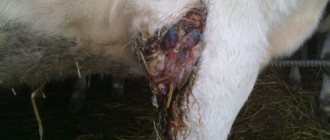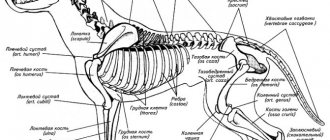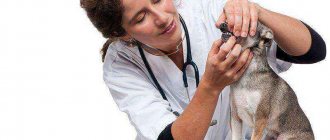Causes
Here are the 14 most common reasons why dogs have sore paws:
- cut out pads;
- calluses;
- yeast infections;
- dirty rashes;
- frostbite or burns;
- foreign body;
- hyperextension injury;
- cracked pads;
- atopy;
- food allergies;
- chemicals on the road or sidewalk;
- parasitic infections;
- lots of walking on the sidewalk;
- arthritis.
Let's take a deeper look at this list.
© shutterstock
Carved pads
Would you walk barefoot? From sharp rocks to broken glass, there are dangers lying on the ground just waiting to be stepped on. Unfortunately, cut-out pads are all too common. The pad has a sponge filling that acts as a shock absorber. And a strong, protective outer layer.
This outer layer is made of keratin, which is what the same nails are made from. Just as a broken nail won't heal, neither will a pad. Everything that happens, over time, the inner “cushion” hardens and stops hurting.
If your dog has a cut pad, contact your veterinarian immediately. Important :
- Check for debris inside the pad;
- Rinse and clean the wound;
- See if it can heal faster with stitches;
- Assess the presence of antibiotics;
Even the unpleasant-looking valve of the paw injury should heal in the present.
Symptoms of pain in dogs
It is not always easy for even the most attentive owner to determine that a dog is in pain, or where exactly it hurts. This is especially difficult with chronic pathologies, for example, osteoarthritis, since this problem intensifies gradually, becomes more pronounced with age, and changes in activity and behavior seem natural.
How to tell if your dog has a sore paw:
- the dog is limping, dragging its paw, or does not lean on it at all, and tightens its grip;
- when trying to touch a limb, vocalization (barking, growling), the dog may snap, the level of aggression increases;
- the dog’s activity has changed, it has become less playful - especially if it is a puppy or young dog;
- the dog begins to jump less, refuses to go up or down stairs, or get in or out of the car;
- The sleeping position has changed, the dog is less likely to take relaxed positions and does not lie on its back;
- with severe pain, loss of appetite and lethargy may occur.
Yeast infections
Yeast infections between dogs' toes are the canine equivalent of athlete's foot in humans.
The yeast responsible is Malassezia (also called pittosporum). She loves warm, moist places - like the toe straps. This causes itching, and when the dog licks the paw, it provides more moisture, which means yeast thrives.
Typical of a yeast infection is that the skin feels a little oily and the coat dirty from licking.
Bathing the paws twice a day with a diluted chlorhexidine solution, drying them well in the meantime, may help, but consult a veterinarian if in doubt.
Dirty rashes
It rained all day long. The fields are a fat stew of mud, and the dog is forever dirty. The dog begins to chew at the feet, and soon an ulcer appears on the top of the paw. This could be a case of mud rash.
Mud rash is more commonly associated with horses, but it exists in a slightly different form in dogs. Dirt is a rich source of bacteria. When dirt remains on the skin, these bacteria can invade scratches and create infections.
Keep paws clean by rinsing and drying with a towel after each walk. If this does not work out, contact your veterinarian as antibiotics may be needed.
© shutterstock
What is lameness
When an animal's gait changes due to a step disorder, they speak of lameness.
In this case, the dog does not step completely on the problematic limb, trying to redistribute the body weight onto healthy paws. At rest, the animal tucks its affected leg.
The front paws are most often damaged because they bear the brunt of the load when jumping and running.
How does lameness manifest?
Even without signs of visible damage, you can understand that your pet has problems with its limbs.
The following symptoms will help identify lameness:
- the inability of the animal to lean on the sore leg;
- pain when walking and at rest;
- inability to stand on the problematic limb from a lying position;
- specific cracking in the joints.
If the pain is severe, the pet will whine and lick its paw. When leaning on a sore limb, the dog stretches its neck forward and throws back its head.
In addition to general signs, there are also other symptoms that characterize the type of disease and the degree of complication.
Frostbite or burns
This seasonal problem may occur more easily than you think. Yes, the pads are hard, but we also allow dogs to play in the snow longer than necessary.
At first, the paws may feel numb and very cold to the touch. The legs are very painful, then after a few days the tissue dies and peels off.
Prevention is key. One thing to keep in mind is how long the dog is outdoors. If it's a long walk, consider safety boots. Once inside, slowly warm your feet with warm (not hot) water.
Also, during the summer months, be careful about hot sidewalks. If it's too hot to hold your hand flat on the paving slab for 5 seconds, then it's too hot for your dog to walk.
Foreign body
A common summer cause of paw pain is migrating grass seeds. These seeds become entangled in the fur between the toes. Their arrow-like shape then penetrates the skin and they migrate below the surface.
This causes pain and irritation, but it is difficult to detect the true ulcer under the fur. Left untreated, grass tent can migrate deep into the soft tissue and cause a serious infection.
Prevention is what we need by checking our feet (and ears) for grass seeds after every walk. But if you miss one and a blister forms on your paw, contact your veterinarian. The dog may need to be calmed to remove the grass blister.
Features of therapy
The exact treatment depends on the cause of the disease. To eliminate spasmodic conditions, nosh-pa and other antispasmodics are prescribed. If the animal experiences pain, a course of analgesics is prescribed in the form of injections. At the same time, the neurologist can offer a course of B vitamins, which restore the normal functioning of nerve fibers.
It is based on supportive treatment with broad-spectrum antibiotic therapy, a vitamin complex, fluid therapy and forced nutrition. There is no treatment that eliminates the virus once the disease has occurred. If the dog is already infected, the administration of the vaccine will no longer have any effect.
The prognosis is maintained, especially if there are associated neurological signs, because they indicate an advanced stage of the disease. Those who survive the disease are prone to behavioral disorders caused by damage to the nervous system. For more information you can click on.
In the treatment of paralysis, blocking individual nerves using novocaine injections has a good effect. The affected muscles can be warmed up, and massage treatments are prescribed. Please note: novocaine blockade is an intervention that is carried out only in a clinic under the supervision of an experienced veterinary neurologist!
Spinal dysplasia is a genetic problem that begins to appear between 4 and 12 months of age. Not all litter puppies develop it, but if your dog does, she should not be crossed. Larger breed dogs have a higher risk of developing hip dysplasia due to the greater weight these animals must bear. But it's important to note that even small dogs can be affected. Large dogs at risk include Rottweilers, German Shepherds, Goldener Restorers, Dalmatians and gundogs.
Hip dysplasia affects endarthrosis of the hip joint. The head of the dog's large paw bone does not fit into the femoral socket. Then instability develops in the joint. This results in more wear and tear than normal. Hip dysplasia can be mild to moderate. In milder cases, the space between the joints is larger than usual and the ball of the femoral plug of bone partially comes out of the cavity. Fortunately, in mild cases there are no arthritic changes associated with the joint.
Atopy
Pain in your dog's paws between the toes may be a sign of atopy (an allergy to something in the environment).
Just as different people are allergic to different allergens, so are dogs. For some pets, the trigger is grass sap, while for others it is pollen. But the symptoms are basically the same, which is excessive itching and licking of the paw.
A clue to atopy is brown paws from the color of saliva.
Atopy is a common problem but has a complex solution. Therapy includes paw washing to remove allergens, as well as modern medications to control itching. This is a lifelong problem, with an emphasis on control rather than treatment.
Is it possible to ignore lameness in a dog?
The lameness may be minor (for example, the pet has slightly twisted its paw, but is running) and will go away on its own. Still, such symptoms cannot be ignored, because this may be a sign of an incipient serious disease of the bones and joints, including oncology.
Lameness is not always associated with limb problems. Sometimes it becomes a concomitant symptom of vertebral hernia, heart disease, gastrointestinal tract and other internal problems.
Food allergies
A dog with a food allergy may develop itching as one of its symptoms. Again, this results in paw licking. Too much licking leads to secondary infections, which in turn leads to painful paws.
The key here is to avoid foods that your dog is allergic to. Talk to your veterinarian regarding a diet trial and feeding a hypoallergenic diet for 8 to 12 weeks .
© shutterstock
Chemicals on the road or sidewalk
The winter months are dangerous for paws, with sidewalks often exposed to road salt and other chemicals.
Wash your paws after every walk. You can also use paw balm to provide a barrier against the elements.
Types of lameness
Depending on the factor that provoked the problem, lameness can be different and manifest itself in different ways.
Types of lameness in animals
| Lameness | Description |
| leaning limb | Soreness occurs when the animal tries to stand on the problematic paw. At the same time, it shows restlessness, refuses to move, whines, and sometimes trembles. |
Pathology occurs when ligaments, tendons, bones are damaged, pads or claws are injured
Painful symptoms can be different in nature, depending on the severity of the damage to the limb.
Functional disorders in animals are divided into 3 degrees:
- The first includes mild lameness, in which the dog is able to briefly place emphasis on the problematic limb, but tries to step on the paw as little as possible to avoid pain.
- Second degree: the pet tries to avoid stepping on the affected limb and carries it forward or presses it forward.
- the third degree is characterized by spasmodic movement of the dog due to the fact that it is generally unable to lean on the affected paw or even move it.
Lameness in dogs is classified according to other parameters depending on the causes of the disease.
Congenital leg defects
There is such a thing as intermittent claudication (also called Patella's disease). She appears suddenly and quickly disappears. It affects dwarf breeds, for which luxation of the kneecap is a common occurrence.
This does not cause any particular problems for the dog, but if repeated frequently, such lameness can lead to degenerative changes.
Another pathology that is inherited is Perthes disease. It is more typical for dwarfs, but the genetic disease can also appear in puppies of other breeds.
Lameness is provoked by deformation of joint and bone tissues that occurs against the background of suddenly developing necrosis.
All other types of lameness are acquired. They can be triggered by mechanical injuries and chemical damage, organ diseases, infections, etc.
Parasitic infections
Some parasites prefer paws. A great example is hookworm. These worms thrive in damp, dirty environments. Dogs walk on this soil, contaminating their paws with hookworm larvae. These larvae then burrow through the skin, causing intense irritation.
Other paw parasites include mites, harvest mites and demodicosis mites. If you suspect parasitism, talk to your veterinarian, as medical treatment for this particular parasite is extremely important.










